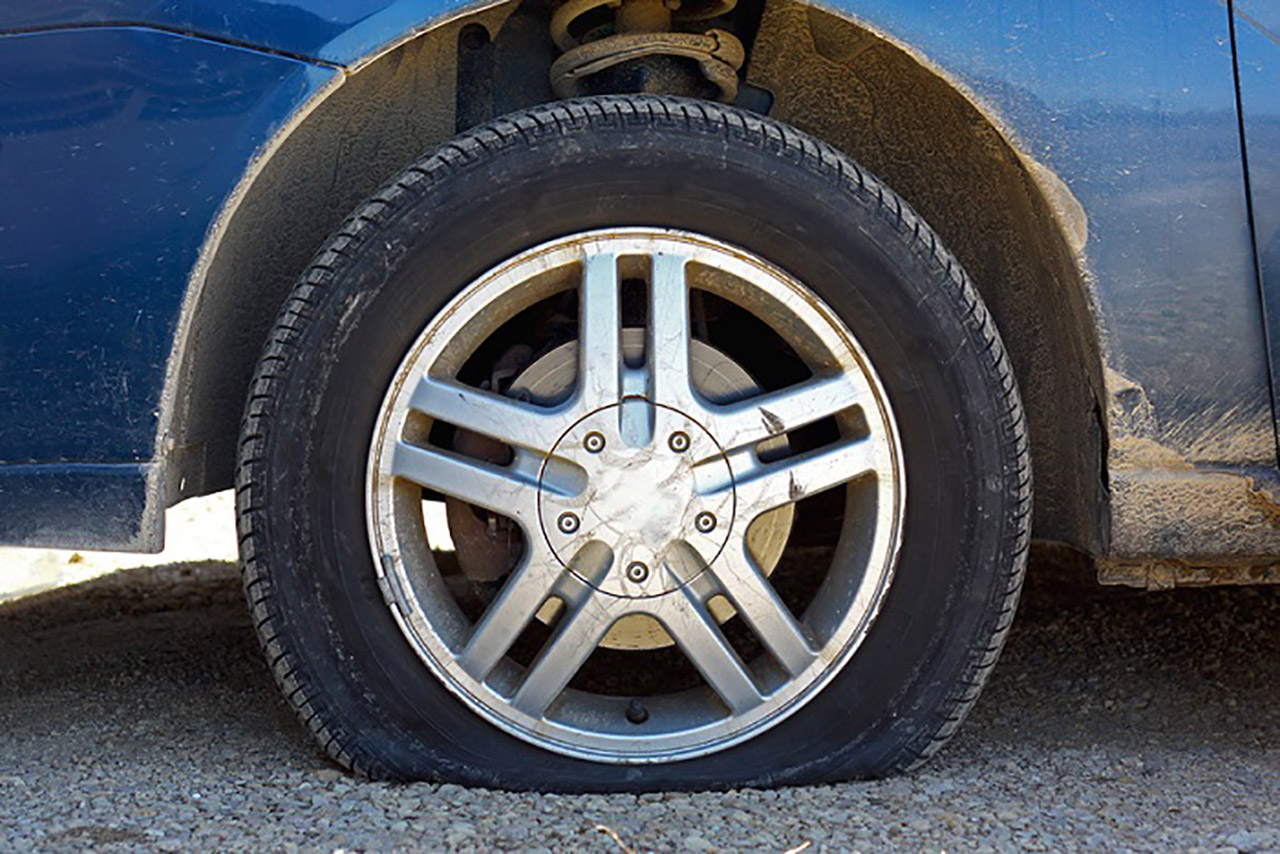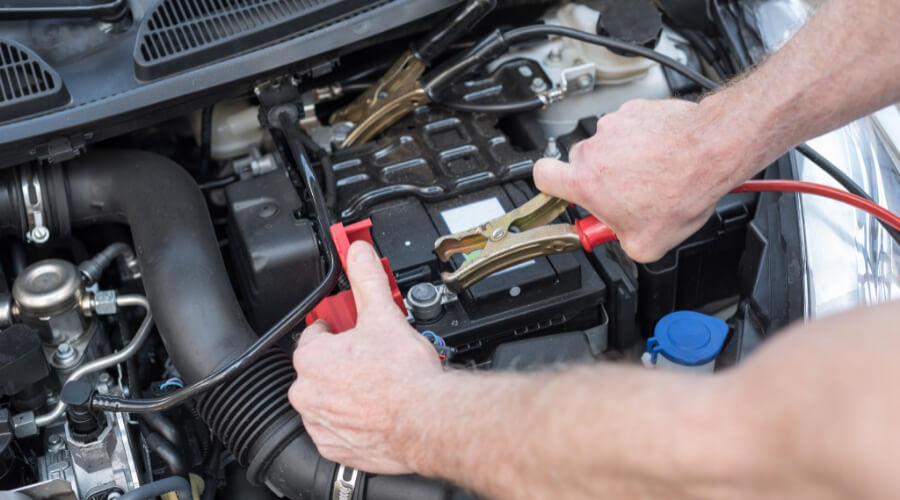How to Change a Flat Tire Safely
A flat tire can quickly derail your plans, whether you're on your way to work, on a road trip, or just running errands. It's not only disruptive, done incorrectly, changing a flat can pose serious safety risks.
Though changing it may seem daunting if you're doing it for the first time, encountering a flat doesn't have to deflate your day or your spirit. It's a task almost anyone can manage with some basic know-how.
That's why we've put together this easy-to-follow guide. Follow along as we prepare you for this common roadside challenge, ensuring you can handle it confidently and get back on the road without any issues, other than perhaps a pair of dirty hands.

- Be Prepared
Having the right equipment is essential for changing a flat quickly and safely. This starts with a spare tire that's ready to be put into service. That's why we recommend checking the condition of your car's spare at least once per year. Whether it's a full-size spare or a space saver (aka "donut"), make sure it's properly inflated and free from damage.
An unusable spare can turn having a flat from a minor inconvenience to a major buzzkill. While you're at it, check the condition of your jack and lug wrench, usually located alongside the spare. You can't change a tire without them.
If your car originally came with run-flat tires, it may not have a spare. No need to panic, though. That's because run-flat tires can drive while deflated, but only for limited distances and speeds. This is true of space-saver spares also. Both are designed to get you no farther than the nearest tire shop -- typically, up to 50 miles at speeds of no more than 50 mph. But check the owner’s manual for the manufacturer’s recommendation.
- Find a Safe Location to Pull Over
If you're driving and realize you have a flat, resist the urge to brake suddenly or swerve. This could cause you to lose control of the vehicle. Instead, slow down gradually, maintaining a steady course as you look for an appropriate and safe place to stop.
Finding the right spot to change a tire might take an extra minute or two, but it's crucial for your safety and the safety of your fellow drivers. Ideal locations include a straight stretch of road with a wide, flat shoulder, an empty parking lot or a quiet side street. Avoid stopping on inclines, which can make it unsafe to jack up the car.
Don’t stop on the side of a high-speed freeway or interstate if you can help it. It’s dangerous to change a tire with traffic whizzing by at 80 mph. Instead, drive slowly along the shoulder to the next exit, and be sure to activate your hazard lights so other drivers can see you and steer clear. If it’s more than a couple of miles it may damage your wheel, but it’s a small price to pay for your own safety.
Leave your hazard lights on throughout the process to warn others sharing the road. Reflective triangles or roadside flares, if you have them, are also helpful for alerting oncoming vehicles, especially at night.
- Secure the Vehicle and Loosen the Lug Nuts
Now, for the dirty work. Once you've navigated to a safe location, ensure the vehicle is securely parked. Turn the car off, place the transmission in park and set the parking brake. If you have a manual gearbox, leave it in gear. These precautions prevent the vehicle from moving as you jack it up. For extra security, you can also chock the wheels opposite the flat tire with a set of wheel wedges or a large rock.
Next, remove the jack, lug wrench and spare from the trunk. But don't make the mistake of jacking up the car first. It's time to loosen the lug nuts, which is safer and easier to do while the flat tire is still in contact with the ground. If a hubcap covers the lugs, gently pry that off. Once the lugs are exposed, use the lug wrench to turn each one counterclockwise until it's loose enough to spin with your fingers. Getting them started might take some force, so be sure you have firm footing.
Remember, you're only loosening the lugs at this point, not removing them completely. This sets the stage for the actual tire change.
- Jack Up the Car and Remove the Flat Tire
With the vehicle securely parked and the lug nuts loose, the next step is to jack up the car and remove the flat tire. Start by identifying your vehicle's designated jack points, typically shown in the owner's manual. Place the jack under the jack point closest to the flat, ensuring it's on solid ground and properly aligned before you begin lifting.
Jack up the vehicle until the flat tire is off the ground. Then unscrew the loose lug nuts completely and keep them together in a place where they won't get lost. Now, you can pull the flat tire off the car. Note that a wheel and tire can weigh as much as fifty pounds combined, so be prepared and ask for help if needed. Once the flat tire is removed, you can roll it out of the way to prepare for the final step.

- Mount the Spare Tire and Finish the Installation
With the flat tire removed, you're ready to mount the spare. To get started, align the lug holes in the spare’s wheel with the bolts protruding from the wheel hub. Then slip the spare onto the hub, pushing it all the way to the base. It shouldn’t require a lot of force. Thread the lug nuts one by one onto each bolt and hand tighten. Make sure they are on straight and screwed as tightly as you can manage with your fingers.
If you have European car, like a BMW or a Mercedes-Benz, it may have a centric setup with lug bolts. If this is the case, simply line up the holes and carefully thread each bolt one by one until it is hand tight.
Now, it's safe to lower the vehicle. Carefully reverse the jack, allowing the wheel to return to the ground. You can remove the jack once the spare fully supports the vehicle’s weight. Then use the lug wrench to tighten the lug nuts completely. We recommend using a crisscross pattern – tighten one lug, then tighten one on the opposite side – back and forth until all are equally snug.
Tighten each lug as much as you can with the strength of your arm. But be careful not to overdo it. For instance, you don't need to put the full force of your body into it. Too much pressure can actually cause a lug to snap off.
With the spare mounted and securely fastened, your vehicle is almost ready to hit the road again. The final step is to stow the jack and lug wrench back in their designated places and load the flat tire into the cargo area.
Unless you are going straight to a repair facility, once you get home, double-check each lug with a torque wrench to make sure it's been tightened properly. Your owner's manual should provide the exact torque specs for your car.
Final Thoughts
Changing a flat tire is a task every driver should be familiar with. If you've never done it before, check all of the tools and spare tire when you don’t need them. It may seem scary, but if a flat tire occurs, following these five steps will make quick work of the job.
Safety is paramount, so take your time and always prioritize your own well-being as well as that of your passengers and fellow drivers. And remember that a spare tire, especially a compact "donut", is only a temporary solution. It's meant to get you to the nearest professional who can repair or replace your flat tire, not for everyday use.
By being prepared and understanding the proper steps, you can confidently and safely change a flat tire when the need arises. You may never have to exercise this skill. But knowing you can when you need to is great peace of mind.
Want to find an auto expert to chat about your tires? Connect with a Tinker Expert Today!



